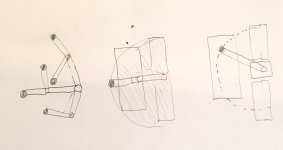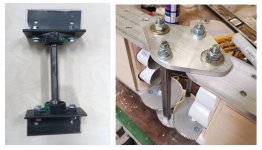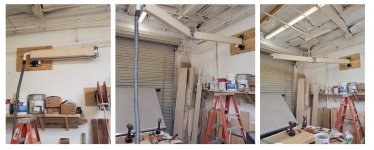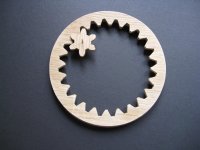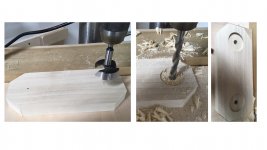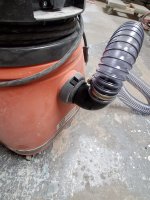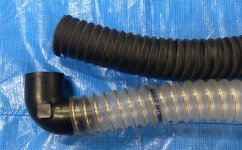martin felder
Member
- Joined
- Dec 17, 2019
- Messages
- 125
For years, I used the Festool non-articulating boom arm as the massive Festool ASA-5000 was not available in the USA and if it was, it would be a bit much for my shop. I liked my Festool 203151 compared to no boom arm, but always thought an articulating boom arm would be better (assuming you do not need portability) for my application. Mounted above cabinets above a workbench with the attached CT-36 below the workbench, no loss of valuable space. Most importantly, the articulating boom arm with an 8-10 ft extended length offers functional advantages.
[attachimg=1]
In the above picture, on the right, with a swivel non-articulating boom arm, the hose comes down along the arc as shown on the drawing on the right. If you want to use a tool like a sander not along the arc, the hose has to be at an angle and can pull on the dust port of the tool. If you have extra length hose to compensate, the hose can drag or lead to the tool wanting to tilt (not good when trying to keep the sander flat) etc. With an articulating boom arm, the hose comes straight down anywhere at all points along the arc and within the arc (shaded in the center drawing). That makes it much easier to use over a much wider area and can swivel easily out of the way. My friend RandyC and I have been working on a DIY homemade boom arm, and here are a few pictures.
[attachimg=2]
[attachimg=3]
[attachimg=4]
This prototype was mounted this past week. Freely articulates, and no sag. Just waiting on the hose. Not expensive to build. This involved a fair amount of drilling and cutting into aluminum. I am working on an alternative model where I will try to make the middle section mostly out of wood using 2 inch OD angled thrust bearings and a 2 inch Forstner bit and then we can do a comparison. It is possible that once we compare these variations, someone with the CNC and machining equipment will be willing to make for others the middle section piece for sale.
For this DIY shop made boom arm, I hope to soon be providing detailed drawings and step-by-step pictures, and links to where you can buy all of the parts. The goal is for you to be able to make a fully articulating 8-10 ft boom arm easily at a cost of $200 - $300. It took a lot of time and some money working on this so that I could have an articulating boom arm myself, and so I figured you could all benefit from my experience with this project. I have benefitted from advice over the years, and happy to give back. To be clear, I have no financial interest in this and am not looking to sell anything or profit in any way. I will keep you posted.
[attachimg=1]
In the above picture, on the right, with a swivel non-articulating boom arm, the hose comes down along the arc as shown on the drawing on the right. If you want to use a tool like a sander not along the arc, the hose has to be at an angle and can pull on the dust port of the tool. If you have extra length hose to compensate, the hose can drag or lead to the tool wanting to tilt (not good when trying to keep the sander flat) etc. With an articulating boom arm, the hose comes straight down anywhere at all points along the arc and within the arc (shaded in the center drawing). That makes it much easier to use over a much wider area and can swivel easily out of the way. My friend RandyC and I have been working on a DIY homemade boom arm, and here are a few pictures.
[attachimg=2]
[attachimg=3]
[attachimg=4]
This prototype was mounted this past week. Freely articulates, and no sag. Just waiting on the hose. Not expensive to build. This involved a fair amount of drilling and cutting into aluminum. I am working on an alternative model where I will try to make the middle section mostly out of wood using 2 inch OD angled thrust bearings and a 2 inch Forstner bit and then we can do a comparison. It is possible that once we compare these variations, someone with the CNC and machining equipment will be willing to make for others the middle section piece for sale.
For this DIY shop made boom arm, I hope to soon be providing detailed drawings and step-by-step pictures, and links to where you can buy all of the parts. The goal is for you to be able to make a fully articulating 8-10 ft boom arm easily at a cost of $200 - $300. It took a lot of time and some money working on this so that I could have an articulating boom arm myself, and so I figured you could all benefit from my experience with this project. I have benefitted from advice over the years, and happy to give back. To be clear, I have no financial interest in this and am not looking to sell anything or profit in any way. I will keep you posted.

